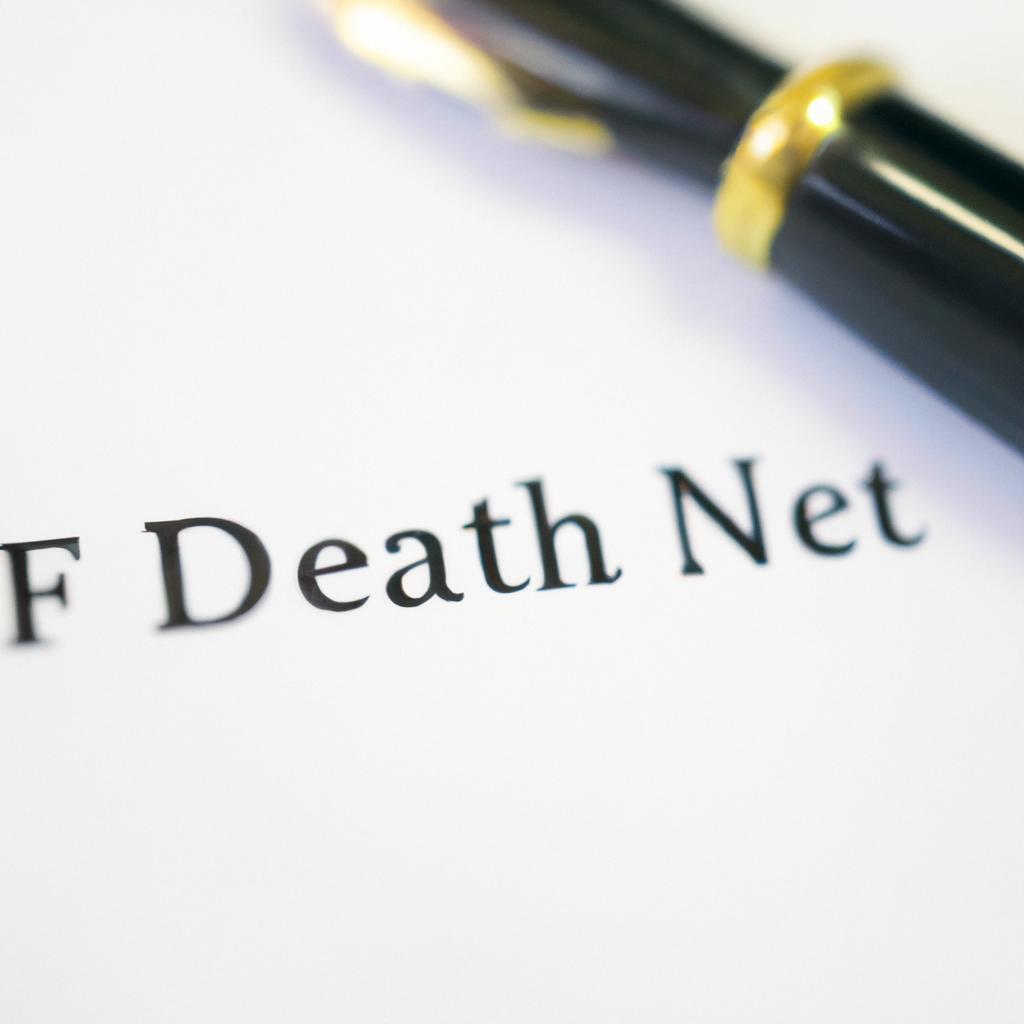In the realm of legal matters surrounding estate planning and probate, the issuance of a short, published notice of a person’s death holds significant importance. This delicate undertaking serves as a crucial step in the process of informing relevant parties of a decedent’s passing, often bearing legal and practical implications that impact the distribution of assets and resolution of estate matters. As seasoned practitioners at Morgan Legal Group in New York City, we understand the intricacies involved in drafting and disseminating such notices with precision and care. Join us as we navigate the nuances of this essential practice in the realm of estate law.
Elements of a Proper Death Notice
When crafting a short, published notice of a person’s death, there are several key elements that should always be included. A well-written death notice not only informs the community of the individual’s passing but also serves as a tribute to their life and legacy. Below are the essential elements that should be included in a proper death notice:
- Name of the deceased: Begin the notice by stating the full name of the individual who has passed away.
- Date and place of death: Include the date and location of the person’s passing to provide context to the reader.
- Surviving family members: List the surviving family members of the deceased, including spouses, children, and siblings.
- Funeral arrangements: Provide details on the upcoming funeral or memorial service for those who wish to pay their respects.

Navigating the Legalities of Publishing a Death Notice
When it comes to publishing a death notice, there are several legalities that must be navigated to ensure compliance with the law. One of the most important considerations is the accuracy of the information included in the notice. It is essential that all details regarding the deceased individual, including their name, date of birth, date of death, and surviving family members, are correct and up to date.
Additionally, it is crucial to obtain consent from the deceased’s next of kin before publishing any information about their death. Failure to do so could result in legal repercussions. It is also important to be mindful of any potential privacy concerns when publishing a death notice, especially when it comes to disclosing sensitive information about the deceased individual or their family members.

How to Craft a Respectful and Informative Death Announcement
When crafting a short, published notice of a person’s death, it is important to convey the information respectfully and informatively. The announcement should be concise yet comprehensive, providing essential details while honoring the memory of the deceased.
Consider the following tips to create a respectful and informative death announcement:
- Include the full name of the deceased
- Mention the date and place of death
- Provide details on the surviving family members
- Include information about any memorial or funeral services
- Express condolences or a brief tribute to the deceased
Remember, a well-crafted death announcement serves as a way to inform others of the loss while also honoring the life of the person who has passed away.

Guidelines for Avoiding Common Pitfalls in Death Notices
When crafting a short, published notice of a person’s death, it is important to ensure accuracy and sensitivity. Here are some guidelines to help you avoid common pitfalls when creating a death notice:
- Double-check all information: Make sure all details, such as the deceased person’s name, age, and date of death, are accurate before publishing.
- Be mindful of the family’s wishes: Respect the family’s privacy and preferences when writing the death notice, and avoid including any information that they may find distressing.
- Include relevant information: Provide information about any funeral or memorial services, as well as donation instructions, if applicable.
By following these guidelines, you can ensure that your death notice is informative, respectful, and free of common errors.
Q&A
Q: What is a short, published notice of a person’s death?
A: A short, published notice of a person’s death, often referred to as an obituary, is a brief announcement that provides key information about the deceased individual, such as their name, age, date of death, and sometimes details about their life and surviving family members.
Q: Why are obituaries important?
A: Obituaries are important as they serve as a way to inform the community of an individual’s passing, pay tribute to their life and legacy, and provide information about funeral arrangements for those who wish to pay their respects.
Q: Who typically writes obituaries?
A: Obituaries are typically written by family members, close friends, or funeral home staff. They may also be written by professional obituary writers hired by the family or newspaper staff.
Q: Where are obituaries usually published?
A: Obituaries are usually published in local newspapers, online obituary websites, and sometimes in community newsletters or church bulletins.
Q: Can anyone have an obituary published?
A: Yes, anyone can purchase a space in a newspaper or online obituary website to have an obituary published. However, some newspapers have guidelines and criteria for what can be included in an obituary.
Q: What information is typically included in an obituary?
A: Typical information included in an obituary includes the deceased person’s full name, date of birth, date of death, surviving family members, predeceased family members, funeral arrangements, and sometimes a brief biography or highlights of the individual’s life.
Q: How can I submit an obituary for publication?
A: To submit an obituary for publication, you can contact the newspaper directly or use an online obituary submission service. Be sure to provide all necessary information and check for any fees associated with publishing the obituary.
In Summary
In conclusion, a short, published notice of a person’s death serves as a poignant reminder of the transient nature of life. These brief announcements, often found in newspapers or online platforms, pay tribute to the deceased and provide an opportunity for friends and family to mourn publicly. While they may be brief, these notices carry a weight of emotion that can resonate with readers long after they have passed. May we all take a moment to honor those who have left us, and cherish the memories they have left behind.
 The topic of death is often a difficult one to discuss. It is a natural part of life, yet it is something that many people are uncomfortable with. However, when a loved one passes away, it is important to inform others of their death in a timely and respectful manner. This is where a short, published notice of a person’s death comes into play.
The topic of death is often a difficult one to discuss. It is a natural part of life, yet it is something that many people are uncomfortable with. However, when a loved one passes away, it is important to inform others of their death in a timely and respectful manner. This is where a short, published notice of a person’s death comes into play.
In this article, we will discuss what a short, published notice of a person’s death is, why it is important, and how to create one. We will also provide practical tips and benefits of using this type of notice, as well as some case studies and firsthand experiences to give you a better understanding of its significance.
What is a Short, Published Notice of a Person’s Death?
A short, published notice of a person’s death, also known as an obituary or death announcement, is a brief written notice that is used to inform others of a person’s passing. It can be published in a newspaper, online, or distributed through social media platforms. This notice typically includes the person’s name, date of death, and sometimes their age and cause of death.
This type of notice can also include information about the person’s life, including their accomplishments, hobbies, and surviving family members. It serves as a way to honor the person who has passed away and inform others of their death.
Why is it Important to Publish a Short Notice of a Person’s Death?
A short, published notice of a person’s death is important for several reasons. Firstly, it serves as a way to inform others of the person’s passing. This is especially crucial for those who were close to the deceased and may not have been informed personally.
Additionally, it allows friends and acquaintances to pay their respects and offer condolences to the family. It also serves as a record of the person’s life and accomplishments, preserving their memory for future generations.
Moreover, publishing a short notice of a person’s death can also serve as a way to celebrate their life and legacy. It allows the family to share fond memories and special moments with others, providing comfort and closure during a difficult time.
How to Create a Short, Published Notice of a Person’s Death?
Creating a short, published notice of a person’s death may seem like a daunting task, especially during a time of grief. However, with these simple steps, you can create a meaningful and effective notice for your loved one.
1. Gather all necessary information: The first step in creating a short, published notice of a person’s death is to gather all the necessary information. This includes the person’s full name, date of birth, date of death, and any other important details you would like to include.
2. Choose the medium: Next, decide on the medium for publishing the notice. This can be in a local newspaper, online on a funeral home’s website, or through social media platforms.
3. Write the notice: When writing the notice, keep it short and to the point. Start with the person’s name, age, and date of death, followed by a brief description of their life, accomplishments, and surviving family members. Be sure to proofread for any errors before publishing.
4. Add a photo: Including a photo can add a personal touch to the notice and allow readers to put a face to the name. Choose a recent photo that captures the person’s spirit and personality.
5. Share the notice: Once the notice is published, share it with family, friends, and acquaintances through email, social media, or by printing physical copies. This will help to spread the word and provide a means for others to offer their condolences.
Benefits and Practical Tips for Creating a Short Notice of a Person’s Death
There are several benefits and practical tips to keep in mind when creating a short notice of a person’s death. These include:
1. Cost-effective: Publishing a short notice of a person’s death is a cost-effective way to inform others of their passing. It is often free to publish online and costs significantly less than a full obituary in a newspaper.
2. Time-sensitive: A short notice can be published quickly, providing timely information to others. This is especially important for those who may need to make arrangements to attend a funeral or pay their respects.
3. Can be shared: Short notices can easily be shared online or through email, allowing you to reach a wider audience and inform more people of the person’s passing.
4. Honors the person’s life: A short notice allows you to honor the person’s life and accomplishments, preserving their memory for years to come.
5. Be respectful: When writing the notice, be sure to use respectful and appropriate language. Consider the person’s beliefs and values when deciding what details to include.
6. Consider length: As the name suggests, a short notice should be brief and to the point. Aim for no more than 200 words to keep it concise and easy to read.
Case Studies and Firsthand Experiences
To better understand the significance of a short, published notice of a person’s death, let’s look at some case studies and firsthand experiences.
Case Study 1: Mary Smith, a widow and mother of three, wanted to inform her relatives and friends of her husband’s passing but was unable to do so personally. She published a short notice of his death in the local newspaper, and many of their extended family members and friends were able to attend his funeral and offer their condolences.
Case Study 2: John Franklin, a retired professor, passed away at the age of 82. His family published a short notice online, which was shared by many of his former students and colleagues. This provided a way for them to express their gratitude for his impact on their lives and share fond memories of his time as a professor.
Firsthand Experience: Sarah Thompson, whose grandfather recently passed away, published a short notice on social media. She received an outpouring of love and support from her friends and acquaintances, who shared kind words and memories of her grandfather. She felt comforted knowing that his memory would live on through their words and thoughts.
In conclusion, a short, published notice of a person’s death is an important and meaningful way to inform others of their passing and honor their life and legacy. By following these tips and guidelines, you can create a powerful and effective notice that will serve as a lasting tribute to your loved one. Remember to be respectful, concise, and to share it with as many people as possible to ensure that the person’s memory lives on.












